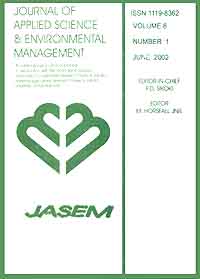
|
Journal of Applied Sciences and Environmental Management
World Bank assisted National Agricultural Research Project (NARP) - University of Port Harcourt
ISSN: 1119-8362
Vol. 23, No. 7, 2019, pp. 1391-1401
|
 Bioline Code: ja19208
Bioline Code: ja19208
Full paper language: English
Document type: Research Article
Document available free of charge
|
|
|
Journal of Applied Sciences and Environmental Management, Vol. 23, No. 7, 2019, pp. 1391-1401
| en |
Ethnobotany of Okomu Forest Reserve, Edo State, Nigeria
UGBOGU, OA & CHUKWUMA, EC
Abstract
An ethnobotanical survey of useful plants was conducted in Okomu forest reserve, with a view to documenting indigenous knowledge of medicinal plants used by the inhabitants of the communities and enclaves around the reserve. Information were obtainedfrom 106 structurally designed questionnaires, which were administered to different individuals and thereafter analysed using descriptive statistics. A total of 90 angiosperm species in belonging to 45 families were identified to be useful in the management of various ailments within the study area. Euphorbiaceae and the Legumes constituted the highest species occurrence while the largest number of plant families (22) had only one species each represented. Further findings showed that the leaves and stem bark are the most useful parts of the plants while the flower and pith were the least useful. In general, the trees were the most useful of all plant habits followed by the herbs and the shrubs. While this work reflects the biodiversity richness of the study area and its environs, it also suggests the enforcement of conservation strategies as a measure to mitigate species loss.
Keywords
Okomu Forest Reserve; ethno-medicine; medicinal plants; conservation
|
| |
© Copyright 2019 - Ugbogu and Chukwuma
|
|
